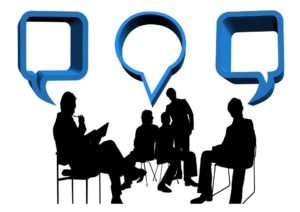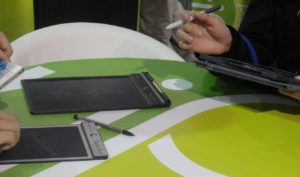![]()

On paper I’m a fairly experienced teacher, having taught for almost 10 years at the time of writing this. Over that time, I’ve also undertaken various forms of professional development and worked in numerous classroom settings. In many respects, I can no longer be thought of as a newbie. However, back in April of this year, I was very much placed in the position of a newbie for the first time in a while, when I was given the challenge of integrating a deaf class member into a compulsory oral English communication course. In all my years of teaching, I’ve never had a learner with any kind of hearing impairment, nor by extension have I really experienced teaching a student with a recognised or self-identified disability. In in-service courses, such as my MA program, my DipTESOL, and even my pre-service CertTESOL, there was never a module, workshop, or focus on teaching English as a foreign or second language to learners with disabilities. This is an issue that has already been raised by my peers. Robert Lowe (2016a) in his article for the Modern English Teacher magazine commented that provisions for SEN – (Special educational needs), are scarcely discussed issues on the above mentioned programs. Lowe suggests that teachers that enter the “ELT profession by following the most common training routes (not including those teachers trained in the state sector) are unlikely to have received any substantial guidance in how to teach students with SEN” (p.73).
I want to use this blog post to describe what I learnt from the experiences teaching a deaf student, with my hope that this piece will help to raise awareness of this undervalued area of our profession, and give you the reader some practical considerations for the classroom. Throughout the time I taught my hearing impaired learner, who for anonymity purposes I shall call ‘Kikuno,’ I kept a diary. After each class I would reflect on an aspect of the lesson that went well, that didn’t work at all, or anything else of relevance. I will refer to my diary as I write this blog.
The teacher as newbie
My class was an English discussion class, a class that required the ability to actively listen and respond to other people’s ideas and express opinions. Kikuno couldn’t speak, nor could she hear the discussions she was involved in. My plans that worked in other classes simply wouldn’t fit this group of learners, and so I had to adjust to the situation before me. The challenge, however, was to allow for integration and not make too much of the obvious differences. There were three areas in particular where adaptations were made. Firstly, I had to script my teacher talk. Before the lesson, I wrote down all of my planned teacher talk on separate sheets of paper that reflected the stages of the lesson. This allowed for Kikuno to follow my speech with the guidance of her note-takers (two student volunteers, one working as her voice, the other as her ears). This largely worked, however I complicated things by improvising, or going off-script. This got better over time as I disciplined myself to stop doing this, ultimately better scripting my instructions so that realtime modifications weren’t necessary. Secondly, the timing and the pacing of activities needed to be reconsidered. With a deaf learner as a member of a discussion group, everything takes a little bit longer. For example, the opinions spoken by the other learners needed to be written down and shown to Kikuno and Kikuno’s own ideas had to be conveyed via the note-takers. I learnt that short pair-work activities, mingling tasks, and other staples of my teaching simply wouldn’t work. Generally, I had to spread everything out, and give everyone more time and space to produce what was required. Finally, I made things a lot more tactile and visual. Phrases for expressing opinions, reasons, and examples were placed on the table for all the learners to use with Kikuno. I also insisted on hand gestures so that Kikuno would know who and when was taking their speaking turn in the discussion.

The learner as newbie
For my learners, it was largely the first time that they’d interacted with a deaf person, let alone shared a classroom with one. For Kikuno, it was the first time that she’d been in a learning environment that wasn’t tailored for hearing impairment. Throughout the process, the other class members quickly learnt the boundaries, particularly the speed at which they should speak and their conduct in discussion tasks. The learners got better at observing the note-takers’ and Kikuno’s styluses, and paying attention to the disparity in speed between spoken and written English. Kikuno also learnt her role in discussions, taking in all the other members’ points of view first before skillfully delivering her own. I also encouraged her not to prepare her ideas whilst she was simultaneously taking in everyone else’s opinions. She gradually learnt that other members would help her to develop ideas collectively, by asking follow-up questions. Over time everyone became more comfortable with the inevitable silences, which led to richer and more meaningful discussions. The other learners came to better understand the value of teamwork in discussions, often holding back the urge to ask questions themselves, in order to give Kikuno the chance to ask one of her own.

A new experience for the institution
This was also a completely new situation for my institution. Throughout the process, I learnt the importance of collaboration with different groups of people. Meetings were routinely held to discuss the best ways to move forward, ideas were exchanged, some of which made it to the class while others were seen as unviable. Concerns and appraisals were also expressed, everyone continuously learning from one another. Above all, everyone learnt the importance of listening to Kikuno herself, for she is the one who could tell us the most about effective procedures. Everyone took note of Kikuno’s insistence and desires to be a fully integrated member of compulsory English program and were happy to run with the uncertainty that such a situation brings. This collaborative process involving Kikuno, various support staff, and myself appears to reflect and is in keeping with Lowe’s (2016b) SEN framework for continuing professional development. Lowe suggests four steps: 1. Student consultation, 2. Internal coaching and mentoring, 3. Outside support and training, and 4. Cascade training and recycling knowledge. It’s at the fourth stage that I find myself now.
Not such a newbie now?
At the time of writing, Kikuno continues to study English, albeit with a different instructor who is likely experiencing the same things that I went through. I now find myself offering my thoughts as advice to her new instructor, which has left me with a great thirst to know more about similar stories and related research in the wider teaching world. Unfortunately, literature dedicated to the teaching of deaf learners in ELT is decidedly lacking, and as I hope my post has shown, the process has very much been trial and error. However, I’m pleased to say that I’ve found some wonderful resources along the way. Fellow iTDi contributor Naomi Epstein’s thought-provoking blog Visualising Ideas is dedicated almost entirely to her experiences in working with deaf and hard of hearing students. I have also found a handful of works that focus specifically on deafness in language learning education, namely Strong (1988) and Swisher (1989), while a more recent title by Judit Kormos and Anne Margaret Smith (2012) provides formative reading around the subject of specific learning differences. So I’m still a newbie, and I’m happy with that. I feel lucky to have been given such a challenge at this stage in my teaching career and will endeavour to make it a part of my continuing professional development through practice and research. I hope the field will also take it on as more of a serious issue.
References
Kormos, J. & Smith, A.M. (2012). Teaching Languages to Students with Specific Learning Differences. Bristol: Multilingual Matters.
Lowe, R. (2016a). Special educational needs coordinators in ELT: A necessary step? The Modern English Teacher, 25(2), 73-75.
Lowe, R. (2016b). Special educational needs in English language teaching: Towards a framework for continuing professional development. ELTED, 19, 23-31.
Strong, M. (1988). Language Learning and Deafness. Cambridge: Cambridge University Press.
Swisher M.V. (1989). The language learning situation of deaf students. TESOL Quarterly, 23(2) 239–258.


One thought on “Teaching a deaf learner: A new experience”